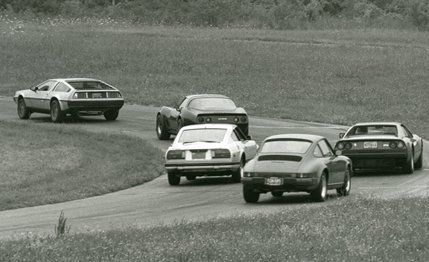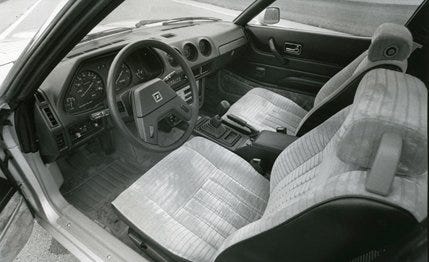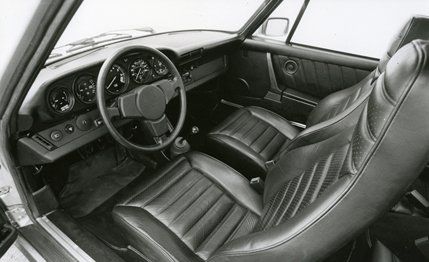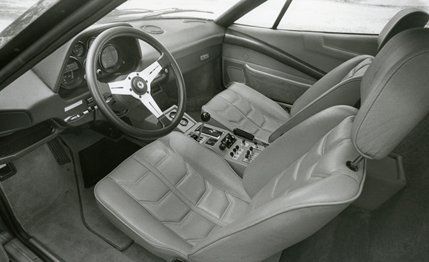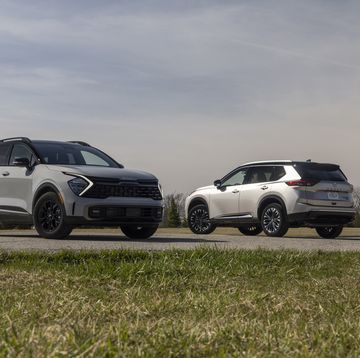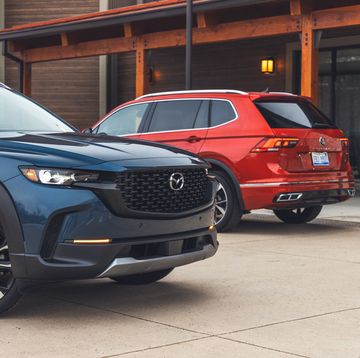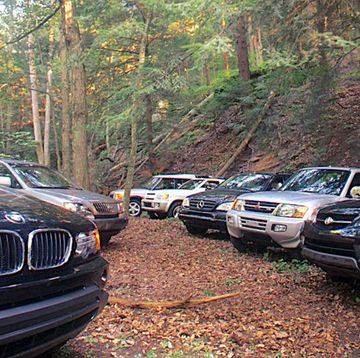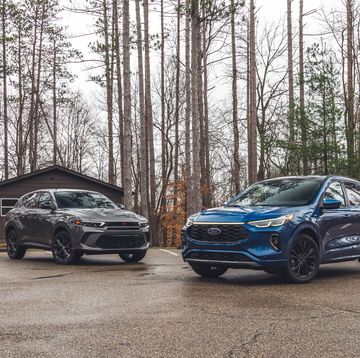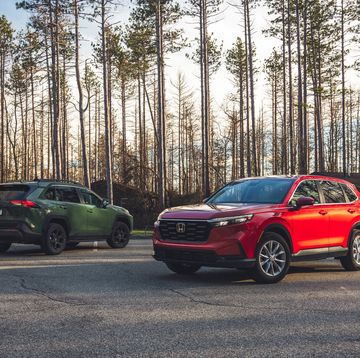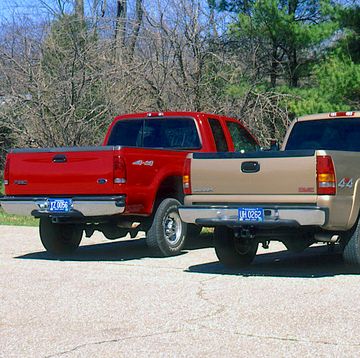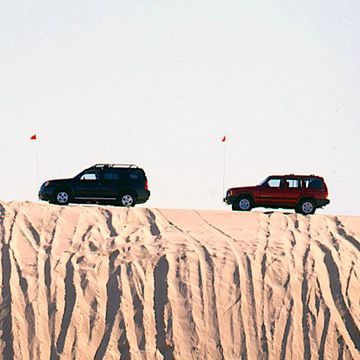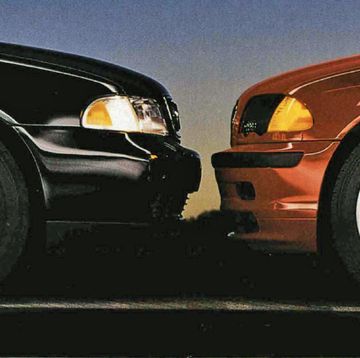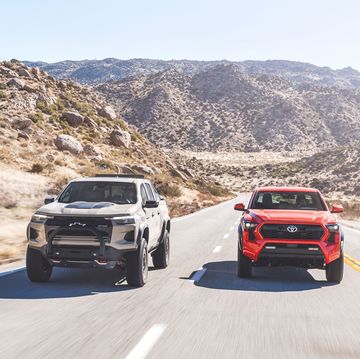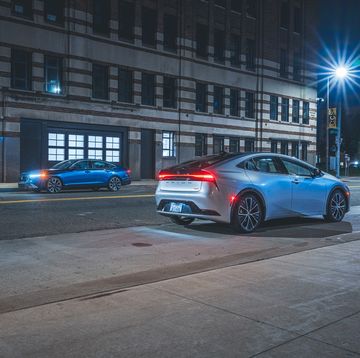From the December 1981 issue of Car and Driver.
The C/D crew could see that he was an officer of the law; not a state cop, but one from the county, though they paid him no more than a sinking glance in verifying this. He had come rumbling out between the clapboard buildings up at the top of the hill and idled slowly down, slowly as only a cop can. They could feel him taking it all in: the quiet country road, the thick trees to one side, the Y-shaped intersection, and them down there along the tail of the Y, off to one side in the little churchyard. With the Ferrari, the Porsche, the Corvette, the Datsun Turbo, and the DeLorean.
The cop eased over onto the gravel shoulder at the lap of the Y and sat gazing out his side window at them. They, chattering madly, as birds faced with the neighborhood cat will do, set about polishing their five already shiny examples of circumstantial evidence.
Had someone put in a call, or was the cop just there because he had a sixth sense? He sat taking in the countryside and the group nearly polished right through the paint (except on the DeLorean, which was being properly spritzed with Windex and dried with paper towels). The chattering tailed off into silence. He'd be down at any moment for a few words, or worse!
As quietly as he'd appeared, he put the cruiser in gear and throttled off up the other wing of the Y. He was obviously devious. Probably going off to the Particular Stretch via some shortcut that would bring him back to it cross-lots. This caused the Designated Runner no end of worry, because it was his tail that would proceed directly to jail should the cop chance to see even a glimpse of what was going on.
A boy on a bicycle came by and said the cop had only been in the area because there'd been some vandalism lately. Pretty soon the Designated Runner breathed a little easier. He buckled himself into another one of the cars and headed off up the hill in a wary eastbound prerun. His road was a carefully selected bitch. The rest of the group stayed behind, passing the time of day in the quiet of the churchyard. In fourteen miles, the Designated Runner would turn around, trip the watches, and head for 140 mph.
We have now, finally, tested the new DeLorean. After years of anticipation and months upon months of negotiations, an actual stainless-steel sports car from Ireland has found its way to the suction cup that holds it fast to our fifth wheel, where it can't hide anymore. As a second line of defense against its escape, we have brought in four of the DeLorean's competitors and ringed them around stockade-style to keep the DeLorean right in the captive perspective.
The category being sports/GT cars, it was only proper to make them jump through the sports/GT hoop. So for our DeLorean and its four adversaries, we arranged a classic three-legged trial by fire: our usual proving-grounds performance testing, a face-off at the Waterford Hills road course, and a final, furious timed attack on an impossible, real-world stretch of Ohio asphalt.
It pleases us no end to announce that John Zachary DeLorean has no reason to mount a rescue attempt for this brainchild. DeLorean and his new factory have done quite a splendid job of producing his car from the ground up. The bugs it bears lie at the easy-to-eliminate end of the scale, and with 3000 DeLoreans—and counting—built by late summer, it is obvious that the car is now ready to account for itself.
Growling around the DeLorean you will find the Ferrari 308GTSi, the Porsche 911SC, the Datsun 280-ZX Turbo, and the Chevrolet Corvette, each representing a very different answer to the same poser of a problem, that of how to get the most driving and viewing pleasure out of a given number of modern dollars. With prices ranging from $17,500 to $56,650, the DeLorean's $25,600 fits right in the middle.
Within these pricing latitudes lies a remarkable range of hardware. The DeLorean has an all-aluminum, overhead-cam, fuel-injected V-6 mounted in front of the rear wheels. The Porsche boasts an all-aluminum, overhead-cam, fuel-injected flat six mounted in the tail of the car. The Datsun antes up an iron-block-and-aluminum-head, overhead-cam, fuel-injected, turbocharged straight six mounted forward of the windshield. The Corvette clings to its heritage with a cast-iron, pushrod, carbureted V-8 mounted behind the hub line of the front wheels.
Looking past these disparities, all five cars have fully independent suspensions, four-wheel disc brakes, and, as tested, five-speed transmissions (except for the Corvette, with its four-speed). Each car also has glass, lights, weather sealing, rubber tires, and room for two conspicuous consumers. Beyond that, these machines celebrate a rainbow of variety, and we'll presume you're here because you want to know what to buy, what to make snide remarks about, and what to worship with glassy-eyed reverence.
DeLorean. Mention of the name gives rise to a wealth of impressions and emotions grown far beyond the toddler stage the car now finds itself in.
Looking at it certainly won't make you think of it as a toddler. Giorgetto Giugiaro has done some significant reworking in order to update the original design he penned so long ago, and the DeLorean is a bellwether in eliciting shouted questions at intersections and close inspections on the road. A polymer chemical treatment is on the way to minimize or alleviate the problem of smudgy fingerprints, which tend to linger grubbily on the stainless-steel skin, and DeLorean recently shipped 30 of his Irish workmen over from Belfast to the company's Quality Assurance Center in Costa Mesa, California, for indoctrination in the kind of precision body-fitting and door-hanging that the boss expects to see. Early cars were cobby in appearance, but our recently produced test car looked terrific overall, and there's more dedication to come. We say that with some confidence, because the 30 workers gave up their annual vacations to the Costa Mesa pledge.
The DeLorean's deformable plastic end caps are an intentionally darker and shinier mismatch with the brushed surface of the body, and this brings a few onlookers' comments, but the nose and tail are exceptionally handsome on their own. The nose appears a tad high ("the retriever sniffed the air...") and there's some extra space between the tires and the front wheel arches, but the lines are crisp and striking. The only visual problem we can see with the stainless-steel body is that it looks dull, very dull, on cloudy days. But let the sun blaze or the night lights sparkle, and the sheen shines. And when the gull wings reach for the sky and their amber warning lights alert the neighborhood's low-flying Learjets to the new obstacle, all the world's air-traffic controllers, striking or not, couldn't channel the glut of instant onlookers.
When they look inside, they lose all control. The original black-leather interior is best saved for the dead-serious souls, but the new pewter-gray one should bring all the special-edition designers in Detroit directly to their knees. It looks wonderful. You fold in and do DeLorean's version of a Nautilus exercise with the tug-down door strap, and all at once They are away in the distance out there and You are gloved in the car.
The sills are high (great for transferring water into your clothing as you get in and out when rain falls), the seats are low, and the backbone frame runs down the middle like a Corps of Engineers breastwork. It was Colin Chapman's corps of consulting engineers at Lotus that arranged it so for Mr. DeLorean, Chapman obviously feeling that any inconvenience encountered in elbowing up to the shift lever would be overcome by the layout's structural advantages. The box-section frame forms a Y at each end to allow the mounting of the radiator, the suspension, and the fuel tank at the front, and the follow-me suspension, the transaxle, and finally the Renault-based V-6 in back.
More than any other car in the test, the DeLorean encloses you, leaves you feeling as though you've sunk into a mammoth beanbag. A few shafts of light enter over the bunker-high cowl and past the thickset A-pillars, the rear roof runners, and a set of those unfortunate matte-black, Venetian-blind slats arrayed behind the back window. Directly beneath that window is an elasticized fishnet to hold whatever baggage you haven't been able to fit into the nicely finished forward trunklet. A pleasingly nappy gray headliner follows every inner contour of the roof and the uppermost surfaces of the gull-wing doors.
DeLorean offers direct fresh air to his customers only through elongated, electrically operated portholes, handy in the otherwise immobile side windows for forfeiting money at gas stations and tollbooths. Mass ingestions of The Big Sky are purely the province of the four pre-established contenders for the throne, which variously offer sunroofs, T-tops, and targa toplessness.
The instrument markings in the car from Northern Ireland are a touch heavy-handed, but the display is clear and logical, as complete as the rest of the interior. With all the expected trappings of comfort and entertainment, only the unreasonable could go away displeased with DeLorean's ergonomic success. A few moments' preflight familiarization will take care of any general questions, and adjustments of the ventilation, the steering column, the seating position, and the stereo system serve to maximize the Friendly Factor.
Tall drivers will fit fine with the seat raked back, and we'll call on John Z. only for modest improvements in lateral and fore-aft seat support, and for something better than the near-deaf, windshield-encapsulated antenna. It doesn't pull in the outside world much better than Marconi's first efforts (the bass and treble controls are a little weak, too). Bring cassettes.
The other cars in the test have been around long enough for massages of attributes and drawbacks alike. The Ferrari 308, for instance, continues to improve with startling rapidity. Even in the face of the DeLorean, the 308's Pininfarina styling is in a league of its own, and last year the car got fuel injection for drivability and a new tightening of quality control. This year it's put together better than ever, and it gets lovely subjective refinements in clutch action (easier and smoother thanks to a new linkage), shift behavior (more natural motions through the gated gear slots, thanks to an inch-taller lever), and ride and handling (thanks to a switch to Michelin TRX tires, inch-taller wheels, and new alignment specifications).
Gone is the old control crankiness that called for a heavy hand. The 308 has assumed its rightful place as a natural road car, no longer wagging between understeer and tail-happiness, now happy to tread the line of your choice without complaint. It has become supremely drivable. The headroom is better in this thin-roofed, pop-top spider than in the coupe, and pedal placement is good for heel-and-toeing, and only the nice leather wheel needs repositioning, its current rake-away rendering it less than helpful in tight corners. That's a small problem in a magnificent car, a car made that way by Fiat's unrelenting surge of improvements. If the 308 doesn't watch out, it's going to be every bit as good as the Ferrari faithful have always believed it to be.
In dealing with the 911SC's rear-engined design, Porsche has had far more ground to make up in handling balance than Ferrari, but a decade and a half of technical advances have proved more than enough. With Bosch K-Jetronic fuel injection much like that of the Ferrari and the DeLorean, the 911SC also enjoys excellent drivability; and whereas the Ferrari delivers a long-legged, thrusting kind of power and the DeLorean a mostly long-legged sort of mild urgency, the Porsche gives great, reaching rushes of honest, ohmigod, pray-for-tomorrow energy transference. This steering acceleration gets lashed to the pavement via Pirelli P7s, and their stickiness and size difference from front to rear take considerable credit for taming in the 911's infamous trailing-throttle oversteer.
The car will tell you everything that's going on, and it will make the planet pass beneath you at a remarkable rate as long as you apply yourself unfailingly to overseeing the chassis's ultimate shortcomings. Otherwise it will spit on your grave. Until that movement, entertainment doesn't come any more satisfying.
The 911SC's standard interior is finished in leather and its seats are built by Recaro, which tells you why it ranks near the top of the list in accommodations. The driving position is high, the outward visibility is virtually unobscured, and the instrumentation is terrific. Once again, Porsche has made its very nice yearly improvements to the once-vague shifter. The brakes are still among the very best in the world, and Germany continues to build the most solid, best-finished car in this group. Like the Ferrari, the 911SC is a whale of a deal if you can afford it.
After the DeLorean, the 280-ZX Turbo is the second most illustrious newcomer on the block. Moreover, we have for you here the first Datsun Turbo five-speed to escape Nissan's prototype shop. This Borg-Warner-built transmission will be an option by the time you read this, and brings with it a number of chassis beefings, some of which Datsun hopes to introduce on regular 280-ZXs and Turbo automatics.
Each five-speed car will be fitted with a modified rear suspension with re-angled lower control arms and relocated pickup points; a modified differential mounting, which alters the deflection-steer characteristics of the rear cross-member for less wigwag in corners; stronger constant-velocity universal joints; spring rates increased 12 percent over the 1981 Turbo's; and shock-absorber rebound control bumped up by 8 percent. Anti-sway-bar sizes remain the same.
Our prototype had most of the new chassis pieces, and the change in ride characteristics was less than desirable. The car was prone to crash, bang, and bound over bumps the Porsche and the Ferrari took little notice of, and that tendency was mixed with a distinct lack of fade resistance on the part of the brakes to make for some truly eye-opening moments at high speeds. The five-speed is more than happy to take you right up there, albeit a little more slowly to 60 mph than the automatic, but it has a stubborn tendency to hang up on two-three upshifts.
Inside, if you like accessories and plush accommodations, all is well in the 280-ZX Turbo. The seating and steering-wheel positions are the best of the five cars, and the multitudinous controls and adjustments are just as well done. The most important addition to the Datsun's comparatively mundane, if practical, exterior is a dashing set of quadrangularly bladed alloy wheels. Except for these whirling eye-catchers, the Turbo's long suit may be its stealthy ability to blend easily with the madding crowd when faced with police power, something none of our other sports/GT aspirants can do worth ducky dung.
Your basic Corvette is about as old as the basic Porsche, and in no way as up to date in execution as the charismatic DeLorean. The Corvette huffs and chuffs with cubic inches and preens in a new thirteen-step paint process that adds an overcoat of clear to make its metallic base last longer and shine brighter. But the plastic Chevy's physical persona remains the same: a caricature in fiberglass that looks racy as hell and fits together like something laid up by Prof. Irwin Corey. The new paint process, introduced when Corvette production was moved to Bowling Green, Kentucky, seems to fill in some of the warp and woof formerly associated with Chevrolet's heavy-hitter. Perhaps the introduction of the long-awaited '83 Corvette will see an across-the-board improvement.
The best part of the current Vette is its effortless low-rpm responsiveness to the throttle. A brush of the pedal in almost any gear causes gaps to open behind the car. Unlike all the others (except perhaps the Porsche, to a lesser extent), the Corvette's transmission is almost superfluous in traffic. Likewise, its massive-section Goodyears exert a rousing influence over smooth pavement, sturdy braking gets forward motion arrested instead of you, and grudging understeer quiets your beating heart when you go ramming into corners.
Meantime, you've got all the standardized GM life-of-Riley appurtenances to keep you company when the squeaks, rattles, and lurches over bumpy roads begin to take their toll on your peace of mind. By that time, the semidreadful seats (to be replaced by Recaros in 1983) may have cricked your spine to a fare-thee-well. The Corvette, more than any other car in this test, requires you to love it a whole lot going in if you're to have much affection for it at all coming out. This car was due a major overhaul it never got way back in the days when John DeLorean was still the man to watch on the GM ladder. Now, like John DeLorean, we are left to balance what each of these cars is against what it does. Sports/GT cars are expected to perform, ideally in some direct proportion to the way they look. The surface answers lie in our results box.
We would qualify the Waterford Hills results only by pointing out that it is one of the tightest road circuits we've ever seen, thus favoring the torquey, big-tired, understeering Corvette. Then again, Corvettes usually turn good times over the smooth and predictable confines of artificial courses, and even had the Porsche not been, shall we say, unexpectedly eliminated from that portion of the competition, it's unlikely it would have surpassing the Corvette's easily posted time without lots of practice.
The Datsun's brakes faded away entirely at the two-lap mark a number of times at Waterford. Because of this failure, the Turbo only managed to match the DeLorean in bringing up the rear. The DeLorean was hampered partly by its Corvairish tendency for the tail to make mild, unwanted advances toward passing its front at awkward times, but more by its simple lack of power. It is not gutless on the road, but neither does it bend your comprehension of acceleration. On the road course, the Ferrari was mainly involved in an internal squabble with its own curb weight, which outweighs its high-speed agility on successions of snug corners. Still, it finished up second best.
It was here that we came to the real world, Ohio style. Do not ask us exactly where the Particular Stretch lies. We are saving its fourteen miles for future unsullied (read, unpatrolled) use. We will tell you only that it is one of the most devilishly tortuous and narrow tracts of pavement ever to give meaning to the words "lumpy" and "unpredictable." It has everything you could ask in order to drain the color right out of anybody's face. It also has one stop sign in the middle of nowhere (which was religiously obeyed); it has virtually no sources for interference except one tiny town with a much-reduced-speed succession of right-angled turns; and, oh, yes, it has a 2.5-mile stretch in the middle across high country that can be taken nigh onto flat-out, except maybe for the big, blind, bounding whoop-dee-doos at about the two-mile mark.
Owing to the nature of the course and the tender sensibilities that live even in the heart of the Designated Runner, each car was given only one timed run and each car was kept on its own side of the road, no cheating. Each could have been asked for a last bit of speed, but the relative results would have remained the same.
The Corvette came off corners like a house afire, but the bumps set it to kicking around like the Rockettes on reds. Its bulk was too unstable to run as fast as you would expect on a wider, smoother road. The Datsun went a-leaping, not as badly as the Corvette, but its brakes went woozy and induced a sickening front-end shudder when making their way down from high speeds. In handling, it was mainly a case of trying to match the suspension's peculiarities with those of the road, managed with limited success. But the Datsun did tie the Corvette in speed.
There were two kings of the hill, and they have the sort of pedigrees that might lead you to imagine them on top: Ferrari and Porsche. They took their work seriously, chewed well, and swallowed what they'd been served with never a flinch. The Porsche answered up with fine acceleration, stunning brakes, a suspension that gave not a single damn how bad the road got, and the feeling that it was about half the size of all the other cars. It was easy to place and a lot less trouble to keep track of than its reputation would have you believe. It was a machine absolutely in its breathtaking element.
What Porsche whipped into line, the Ferrari nonchalantly balanced across. Its feeling through the controls was exactly one of ideal coordination. It gathered that scofflaw road under its wing, gave it a little scolding, and sent it on its way the wiser. Its suspension feels as if it has a little less travel than the Porsche's, and its brakes are not quite as inspiring, but it has that gift of drivability that makes it perhaps the most pleasing of all.
But you should not be concerned for the DeLorean. Yes, it was the slowest in Ohio, just as it was in most of the proving-ground tests and at Waterford Hills, but then it's got tall gearing, excess curb weight, and the weakest engine. And the best fuel economy. However...its performance outlook is likely to do a complete about-face if John Z.'s deal with Legend Industries, the builders of Fiat's turbo roadsters, bears the twin-turbocharged fruit he's counting on. Engineers at DeLorean are already anticipating the upgradings they will have to make in Mr. Chapman's chassis, but they must be sustaining themselves with thoughts of the legend wrought by the Porsche 930 Turbo.
One of the first things DeLorean's technical leprechauns should address themselves to is his car's tendency to get very antsy indeed at hyperspeed over bad pavement. Hopping, darting, and corkscrewing motions are not the stuff of confidence (we suspect that a distinct lack of torsional stiffness between the backbone and the body is the problem), especially when the car cuts into one's outward vision as severely as the DeLorean does.
But such things need not concern California executives and similar breeds, because John's DeLorean will provide them with all the flash and substance they need—and for a car so new and so different, that's a bunch already. What DeLorean has here is no less than the executive sports car.
If DeLorean keeps this up, he could be the only North American besides Henry Ford to leave his mark and his name on this business for the foreseeable future. It's a long row, but John Z. DeLorean is out here hoeing like mad.
And the Designated Runner is standing by for the twin-turbo, hoping for no cops.


